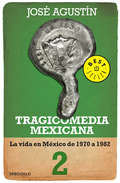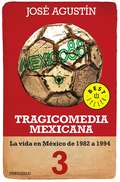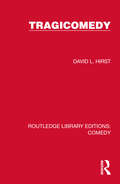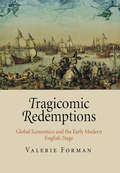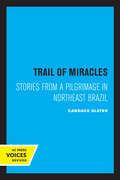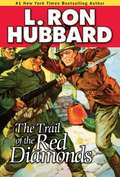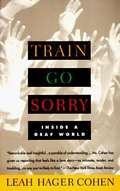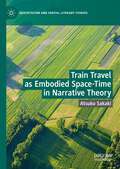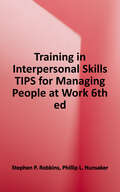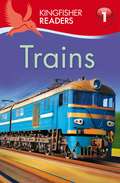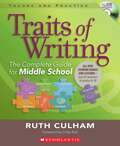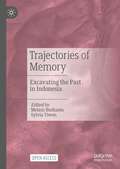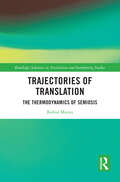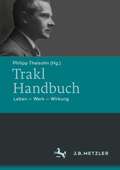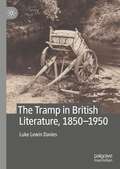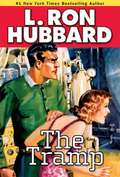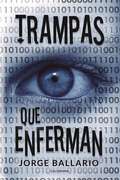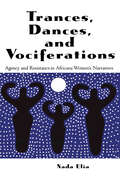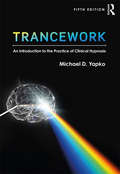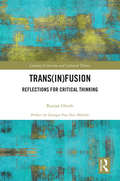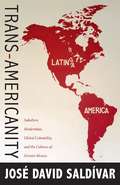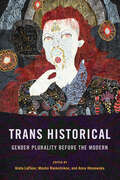- Table View
- List View
Tragicomedia mexicana 2: La vida en México de 1970 a 1982 (Tragicomedia mexicana #Volumen 2)
by José AgustínUna excepcional crónica de la vida social, política, cultural y económica en México de 1970 a 1982. En este segundo volumen de la Tragicomedia mexicana, que comprende de 1970 a 1982, tenemos el "superpresidencialismo tercermundista" y sus respuestas al 68, la guerra entre la iniciativa privada y el presidente Echeverría, la crisis económica y el Fondo Monetario Internacional, los providenciales yacimientos de petróleo, la "abundancia" y el derroche, la reforma política de López Portillo, el avance incontenible de la contaminación, la corrupción, la aplastante influencia de Estados Unidos, la deuda "eterna", las devaluaciones y la nacionalización de la banca, la revolución y la "contrarrevolución cultural", las nuevas mafias literarias, el nuevo periodismo, la nueva dramaturgia, el nuevo cine, el feminismo, las luchas de los grupos gay, Avándaro, los chavos banda, el nacimiento del rock mexicano y el inicio de la década perdida.
Tragicomedia mexicana 3: La vida en México de 1982 a 1994 (Tragicomedia mexicana #Volumen 3)
by José AgustínUna excepcional crónica de la vida social, política, cultural y económica en México de 1982 a 1994. En este tercer volumen de la Tragicomedia mexicana, que comprende de 1982 a 1994, tenemos los años de la crisis, los "nuevos pobres", la globalización y las privatizaciones, la "renovación moral", los tecnos y los dinos, la renegociación de la deuda externa, la privatización de la banca, el fortalecimiento del narcotráfico, el terror del sida, la explosión de San Juanico y el terremoto de 1985, la "caída" del sistema en 1988, la familia Salinas, los negocios del hermano incómodo, el dinero de Pronasol, los nuevos megamillonarios, los cambios en el campo, la relación con la Iglesia católica y el Tratado de Libre Comercio, el dedazo "prematuro", la rebelión zapatista, Marcos Superstar, la "candidatura alterna", el asesinato de Luis Donaldo Colosio, la muerte de Ruiz Massieu y otra, más devastadora aún, crisis económica. Qué bonito acabamos, igual que empezamos.
Tragicomedy (Routledge Library Editions: Comedy)
by David L. HirstIn this brief study, originally published in 1984, David Hirst examines the meaning of the term ‘tragicomedy’ by elucidating the most important theories of the genre and by analysing those plays which represent its most vital and influential expression. He draws a distinction between tragicomedies and conceived as a careful fusion of contrasted dramatic elements and as a mixed genre which seeks to exploit a volatile combination of theatrical extremes. In the first part he compares neo-classical romance and satire. The plays of Shakespeare, Fletcher and Corneille, seen in the context of the literary theory of Guarini, are contrasted with Marlowe and the writers of revenge tragedy. The second part examines the conflict of Romanticism and realism in nineteenth- and twentieth-century theatre. Shaw, Chekhov and the Absurdists are viewed in relation to the key theories of tragicomedy expounded by Brecht, Artaud and Pirandello. The study concludes with a consideration of certain significant contemporary plays – by Edward Bond, Peter Nichols and Peter Barnes – in the context of the historical development of the genre.
Tragicomic Redemptions
by Valerie FormanIn the early modern period, England radically expanded its participation in an economy that itself was becoming increasingly global. Yet less than twenty years after the highly profitable English East India Company made its first voyage, England was suffering from an economic depression, blamed largely on the shortage of coin necessary to exploit those very same profitable routes. How could there be profit in the face of so much loss, and loss in the face of so much profit?In Tragicomic Redemptions, Valerie Forman contends that three seemingly unrelated domains--the development of new economic theories and practices, especially those related to global trade; the discourses of Christian redemption; and the rise of tragicomedy as the stage's most popular genre--were together crucial to the formulation of a new and paradoxical way of thinking about loss and profit in relationship to one another.Forman reads plays--including Shakespeare's Twelfth Night, The Merchant of Venice, Pericles, and The Winter's Tale, Fletcher's The Island Princess, Massinger's The Renegado, and Webster's The Devil's Law-Case--alongside a range of historical materials that provide a fuller picture of England's participation in a global economy: the writings of the country's earliest economic theorists, narrative accounts of merchants and captives in the Spice Islands and the Ottoman Empire, and documents that detail the development of the English East India Company, the Levant Company, and even the very idea of the joint-stock company. Unique in its dual focus on literary form and economic practices, Tragicomic Redemptions both shows how concepts fundamental to capitalism's existence, such as "free trade," and "investment," develop within a global context and reveals the exceptional place of dramatic form as a participant in the newly emerging, public discourse of economic theory.
Trail of Miracles: Stories from a Pilgrimage in Northeast Brazil
by Candace SlaterThis title is part of UC Press's Voices Revived program, which commemorates University of California Press’s mission to seek out and cultivate the brightest minds and give them voice, reach, and impact. Drawing on a backlist dating to 1893, Voices Revived makes high-quality, peer-reviewed scholarship accessible once again using print-on-demand technology. This title was originally published in 1986.
Trail of the Red Diamonds
by L. Ron HubbardA pulse-pounding adventure that would put Indiana Jones on edge. Most copies of The Travels of Marco Polo leave out a great deal and are difficult to decipher. Yet when one original manuscript lands in the hands of Lieutenant Jonathan Daly, he's able to translate the tale well enough to discover the trail to a chest of fabulous red stones buried with the long-dead Emperor of China, Kubla Kahn. An offering to the gods to light the leader's way to heaven, the glittering stones are worth several million dollars, as they are diamonds.Recently recovered from a bout of malaria and two bullet holes collected in war-ravaged Gran Chaco, Lieutenant Daly sets out on his treasure travels, ignoring warnings from friends and doctors. He follows Marco Polo's words straight into a dark maze of betrayal, espionage and death--with more riding on each precious line of text than he ever imagined. ALSO INCLUDES THE ADVENTURE STORY "HURRICANE'S WAR""... a very strong Indiana Jones feel to it, even though it predates Indy by nearly five decades....an exciting story that keeps readers glued to the page: Hubbard at his best." --Booklist* An International Book Awards Winner
Train Go Sorry: Inside a Deaf World
by Leah Hager CohenThis portrait of New York's Lexington School for the Deaf is not just a work of journalism. It is also a memoir, since Leah Hager Cohen grew up on the school's campus and her father is its superintendent. As a hearing person raised among the deaf, Cohen appreciates both the intimate textures of that silent world and the gulf that separates it from our own.
Train Travel as Embodied Space-Time in Narrative Theory (Geocriticism and Spatial Literary Studies)
by Atsuko SakakiTrain Travel as Embodied Space-Time in Narrative Theory argues that the train is a loaded trope for reconfiguring narrative theories past their “spatial turn.” Atsuko Sakaki’s method exploits intensive and rigorous close reading of literary and cinematic narratives on one hand, and on the other hand interdisciplinary perspectives that draw out larger connections to narrative theory. The book utilizes not only narratological frameworks but also concepts of space-focused humanity oriented social sciences, such as human geography, mobility studies, tourism studies, and qualitative/experience-based ethnography, in their post “narrative turn.” On this interface of narrative studies and spatial studies, this book pays concerted attention to the formation of affordances, or relations in which the human subject uses a space-time and things in it, in terms of passenger experience of the train carriage and its extension. Affiliation: Atsuko Sakaki, University of Toronto, Toronto, Canada.
Training for Catastrophe: Fictions of National Security after 9/11
by Lindsay ThomasA timely, politically savvy examination of how impossible disasters shape the very real possibilities of our worldWhy would the normally buttoned-down national security state imagine lurid future scenarios like a zombie apocalypse? In Training for Catastrophe, author Lindsay Thomas shows how our security regime reimagines plausibility to focus on unlikely and even unreal events rather than probable ones. With an in-depth focus on preparedness (a pivotal, emergent national security paradigm since 9/11) she explores how fiction shapes national security.Thomas finds fiction at work in unexpected settings, from policy documents and workplace training manuals to comics and video games. Through these texts—as well as plenty of science fiction—she examines the philosophy of preparedness, interrogating the roots of why it asks us to treat explicitly fictional events as real. Thomas connects this philosophical underpinning to how preparedness plays out in contemporary politics, emphasizing how it uses aesthetic elements like realism, genre, character, and plot to train people both to regard some disasters as normal and to ignore others.Training for Catastrophe makes an important case for how these documents elicit consent and compliance. Thomas draws from a huge archive of texts—including a Centers for Disease Control comic about a zombie apocalypse, the work of Audre Lorde, and the political thrillers of former national security advisor Richard Clarke—to ask difficult questions about the uses and values of fiction. A major statement on how national security intrudes into questions of art and life, Training for Catastrophe is a timely intervention into how we confront disasters.
Training in Interpersonal Skills: Tips for Managing People at Work
by Stephen P. Robbins Phillip L. HunsakerAn applied approach to developing and practicing interpersonal skills. By developing and practicing the material in Training in Interpersonal Skills, readers can learn how to build productive relationships in any situation. This text also helps readers master the skills necessary for personal and organizational effectiveness such as self-management, communication, teaming, and problem-solving. The sixth edition includes several new pedagogical tools such as self-assessment quizzes, exercises, cases, etc.-and information on the importance and usage of social networking.
Trains (Kingfisher Readers L1)
by Thea FeldmanKingfisher Readers L1: Trains by Thea Feldman LEVEL 1 - BEGINNING TO READ (red) The language at this level will be short and simple sentences, with straightforward vocabulary and punctuation, a high level of phonic regularity and lots of repetition. Includes simple glossary. The amazing photography in this book will grab readers from the first page and keep them turning for more. Covering all aspects of trains from how they go, to who rides, who drives, and all of the various architecture of a train system, this book's photographs and text work together seamlessly to introduce new vocabulary and help decode the words in context to build confidence for more reading success.
Traits of Writing: The Complete Guide for Middle School
by Ruth CulhamEffective, easy-to-use tools for trait-based assessment and instruction―just for middle school teachers. Includes printable reproducible forms! The traits have revolutionized the way writing is taught. And nobody knows the traits better than Ruth Culham, who has written over 25 books and conducted countless workshops for teachers of all grades. Now, Ruth turns her expert eye to middle school. The Traits of Writing: The Complete Guide for Middle School contains classroom-tested materials developed just for teachers of grades 6-8. Brand-new scoring guides, scored sample papers, Think Abouts, warm-up exercises, focus lessons, and activities for each trait, organized by that trait's key qualities, make it easy to assess writing and deliver targeted instruction. With CD of reproducible forms that is compatible with interactive white boards. - The most comprehensive guide to trait-based teaching in middle school- An all-in-one resource for building a writing traits classroom, from the ground up- Useful trait-focused tips and tools that enable middle school teachers to hit the ground running- Research-based strategies, presented in a friendly, encouraging tone- The perfect companion to Culham's other trait resources
Trajectories of Memory: Excavating the Past in Indonesia
by Melani Budianta Sylvia TiwonThis book is a collection of essays in Indonesian history and archaeology dealing with different and multiple trajectories, along four broad themes. The first part of the book covers competing or evolving representations of events, customs or traditions, and historical personae in Indonesian official and popular expression, as they are shaped by economic, political, and cultural forces. The second part deals with memories of war and peace, examining transnational conflict and collaboration, the role of political elites and state projects dealing with the aftermath of military aggression, while also focusing on the impact and responses of civilians. The third part focuses on how state and civil societies frame historical figures, in ways that transcend the dichotomy of heroes and victims. The fourth part of the book looks at the way Indonesian museums and museology serve as sites where new kinds of memory work occur, in a post-1998 era.The book is designed with the aim of clearing a space for a plurality of memory works. Discussions in this volume extend from Loloda island in Eastern Indonesia, to Sabang island at the north westernmost end of the archipelago, and to the cosmopolitan centers. Temporally, it covers the colonial, the post-independence and contemporary eras. By juxtaposing diverse works, the book offers a new vista of multiple trajectories of memory being traced out in and about Indonesia.This is an open access book.
Trajectories of Translation: The Thermodynamics of Semiosis (Routledge Advances in Translation and Interpreting Studies)
by Kobus MaraisThis book builds on Marais’s innovative A (Bio)Semiotic Theory of Translation to explore the implications of this conceptualization of translation as the semiotic work from which social-cultural reality emerges and chart the way forward for applications in empirical research. The volume brings together some of the latest developments in biosemiotics, social semiotics and Peircean semiotics with emergent work in translation studies towards better understanding the emergence of trajectories in society-culture through semiotic processes. The book further develops lines of thinking around thermodynamics in the work of Terrence Deacon to consider the ways in which ideas emerge from matter, creating meaning, and its opposites, namely the ways in which ideas constrain matter. Marais links these theoretical strands to empirical case studies in the final three chapters towards operationalizing these concepts for further empirical work. This book is aimed at academics in the fields of translation studies, semiotics, multimodal/multimedial studies, cultural studies and development studies. It will also be applicable to postgraduate students in these fields.
Trakl-Handbuch: Leben - Werk - Wirkung
by Philipp TheisohnDas Werk Georg Trakls (1887-1914) ist ebenso schmal wie bedeutend. Er gilt als Klassiker der Moderne und seine Gedichte gehören zum Kanon auch in Universität und Schule. Gleichwohl hat die Hermetik seiner Dichtung zu vielen offenen Forschungsfragen geführt. Das Handbuch stellt das Gesamtwerk dar und enthält viele exemplarische Gedichtanalysen. Darüber hinaus informiert es über Biographie, Werkkonstitution, Einflüsse und Rezeption (etwa auch Trakl-Vertonungen). Zentrale Diskurse und Topoi der Trakl-Forschung werden in Querschnitt-Artikeln erläutert. Zeittafel und umfangreiche Register beschließen den Band.
The Tramp in British Literature, 1850—1950
by Luke Lewin DaviesThe Tramp in British Literature, 1850–1950 offers an account of the emergence of a new conception of homelessness in the mid-nineteenth century, which it argues reflects the evolution of capitalism and disciplinary society in this period. In the process it uncovers a neglected body of literature on the subject of the tramp written by thirty-three memoir writers and eighteen fiction writers, most of whom were themselves homeless. In analysing these works, The Tramp in British Literature presents select texts as a unique and ignored contribution to a wider radical discourse defined by its opposition to a societal fixation upon the need to be productive.
Tramp, The
by L. Ron HubbardExplore this fantastical tale. Down-on-his-luck tramp Doughface Jack has been shot while trying to escape from a cop and a train brakeman--causing him to fall from the train and crush his skull. A local doctor performs emergency surgery to save Doughface's life, patching up and stitching together the two halves of his brain and then sealing the cranium with a silver bowl.While Doughface miraculously survives, he also acquires phenomenal mental powers: he can instantaneously heal or kill, or make the old young. Terrified of his newfound abilities, Doughface flees the university where he was being kept for examination, only to cross paths with a vengeful and beautiful woman bound to reach the ultimate seat of power--using Jack to destroy anything that gets in her way! "...a series not to be missed by any true pulp-fiction fan." --Comics Buyers Guide
Trampas que enferman
by Jorge BallarioDescubre cómo los anzuelos ideológicos cotidianos nos colonizan la mente y nos quitan la salud. La vorágine cultural y comercial de esta era de la exageración sobreexige a las personas y coloniza sus mentes, no sin antes estresarlas y agotar sus defensas. <P><P>Los afectados se vuelven proclives, entre otros males, a la enfermedad. En paralelo, el exceso de racionalidad que producen el discurso tecnocientífico, la lógica empresario-mercantil y el mundo -en teoría- carente de fallas de la informática fomentan otra fuente de patología: la rigidez de pensamiento. <P><P>Ante esta preponderante dificultad para gestar una cultura más saludable, la única salida individual será armonizar nuestro mundo mental, y con ello obtener más margen para la salud. Solo así podremos enfrentar airosamente los avatares de la vida actual, que tiende a desorientarnos y a alejarnos de nosotros mismos.
Trances, Dances and Vociferations: Agency and Resistance in Africana Women's Narratives
by Nada EliaTrances, Dances and Vociferations provides a compelling feminist analysis of gender politics in the works of four major Africana women writers: Toni Morrison, Michelle Cliff, Assia Djebar, and Paule Marshall. Nada Elia explores the way in which black women characters use conjuring, double entendre, and song to empower, liberate and determine their own female insurgency. She also explains how African and Afrodiasporic women have been forced to rewrite history and substitute a communal and individual wholeness for alienation and separation in many different settings, from Algeria to Oklahoma. Ranging over works including Marshall's Praisesong for the Widow, Djebar's A Sister to Scheherazade, Cliff's No Telephone to Heaven and Morrison's Jazz and Beloved, Elia offers essential and provocative insights into the works of some of our most influential Africana women authors today.
Trancework: An Introduction to the Practice of Clinical Hypnosis
by Michael D Yapko Michael D. YapkoFor nearly four decades, Trancework has been the definitive textbook for thousands of professionals undergoing training in the art and science of clinical hypnosis. Now in its 5th edition, this classic text continues its legacy of encouraging sound clinical practice based in established scientific research. This latest edition incorporates new studies and emerging topics within the field of hypnosis, including new chapters on depression and the construction of process-oriented interventions. Readers can expect to receive a comprehensive overview of current developments in the domain of hypnosis, an in-depth consideration of the practical and ethical issues associated with its use, and a greater appreciation for its many therapeutic applications. This thorough, engaging text equips professionals with the essential skills to change clients’ lives by using hypnosis to enhance treatment of both medical and psychological issues.
Trans: Reflections for Critical Thinking (Literary Criticism and Cultural Theory)
by Ranjan GhoshTrans(in)fusion is a highly original book that tries to radicalize our ways of ‘critical thinking’ across disciplines. The book, refreshingly, brings into play critical philosophy, literary criticism, studies in mathematics, physics, chemistry and developmental biology, and various other disciplines and epistemes to set up a tenure and tenor of ‘critical thinking’. The book is an exclusive intervention in how thinking across traditions and systems of thought can generate distinct interpretive experiences. It questions, in a unique transcultural and transversal bind, our ways of hermeneutic and literary-cultural thinking. Trans(in)fusion resets the dialectics between text and theory.
Trans-Americanity: Subaltern Modernities, Global Coloniality, and the Cultures of Greater Mexico
by José David Saldívar Donald E. PeaseA founder of U.S.-Mexico border studies, José David Saldívar is a leading figure in efforts to expand the scope of American studies. In Trans-Americanity, he advances that critical project by arguing for a transnational, antinational, and "outernational" paradigm for American studies. Saldívar urges Americanists to adopt a world-system scale of analysis. "Americanity as a Concept," an essay by the Peruvian sociologist Aníbal Quijano and Immanuel Wallerstein, the architect of world-systems analysis, serves as a theoretical touchstone for Trans-Americanity. In conversation not only with Quijano and Wallerstein, but also with the theorists Gloria Anzaldúa, John Beverley, Ranajit Guha, Walter D. Mignolo, and Gayatri Chakravorty Spivak, Saldívar explores questions of the subaltern and the coloniality of power, emphasizing their location within postcolonial studies. Analyzing the work of José Martí, Sandra Cisneros, Toni Morrison, Arundhati Roy, and many other writers, he addresses concerns such as the "unspeakable" in subalternized African American, U.S. Latino and Latina, Cuban, and South Asian literature; the rhetorical form of postcolonial narratives; and constructions of subalternized identities. In Trans-Americanity, Saldívar demonstrates and makes the case for Americanist critique based on a globalized study of the Américas.
Trans Historical: Gender Plurality before the Modern
Trans Historical explores the plurality of gender experiences that flourished before the modern era, from Late Antiquity to the eighteenth century, across a broad geographic range, from Spain to Poland and Byzantium to Boston. Refuting arguments that transgender people, experiences, and identities were non-existent or even impossible prior to the twentieth century, this volume focuses on archives—literary texts, trial transcripts, documents, and artifacts—that denaturalize gender as a category. The volume historicizes the many different social lives of sexual differentiation, exploring what gender might have been before modern medicine, the anatomical sciences, and the sedimentation of gender difference into its putatively binary form.The volume's multidisciplinary group of contributors consider how individuals, communities, and states understood and enacted gender as a social experience distinct from the assignment of sex at birth. Alongside historical questions about the meaning of sexual differentiation, Trans Historical also offers a series of diverse meditations on how scholars of the medieval and early modern periods might approach gender nonconformity before the nineteenth-century emergence of the norm and the normal. Contributors: Abdulhamit Arvas, University of Pennsylvania; Roland Betancourt, University of California, Irvine; M. W. Bychowski, Case Western Reserve University; Emma Campbell, Warwick University; Igor H. de Souza, Yale University; Leah DeVun, Rutgers University; Micah James Goodrich, University of Connecticut; Alexa Alice Joubin, George Washington University; Anna Kłosowska; Greta LaFleur; Scott Larson, University of Michigan, Ann Arbor; Kathleen Perry Long, Cornell University; Robert Mills, University College London; Masha Raskolnikov; Zrinka Stahuljak, UCLA.
Trans-Indigenous: Methodologies for Global Native Literary Studies (Indigenous Americas)
by Chadwick AllenWhat might be gained from reading Native literatures from global rather than exclusively local perspectives of Indigenous struggle? In Trans-Indigenous, Chadwick Allen proposes methodologies for a global Native literary studies based on focused comparisons of diverse texts, contexts, and traditions in order to foreground the richness of Indigenous self-representation and the complexity of Indigenous agency.Through demonstrations of distinct forms of juxtaposition—across historical periods and geographical borders, across tribes and nations, across the Indigenous–settler binary, across genre and media—Allen reclaims aspects of the Indigenous archive from North America, Hawaii, Aotearoa New Zealand, and Australia that have been largely left out of the scholarly conversation. He engages systems of Indigenous aesthetics—such as the pictographic discourse of Plains Indian winter counts, the semiotics of Navajo weaving, and Maori carving traditions, as well as Indigenous technologies like large-scale North American earthworks and Polynesian ocean-voyaging waka—for the interpretation of contemporary Indigenous texts. The result is a provocative reorienting of the call for Native intellectual, artistic, and literary sovereignty that fully prioritizes the global Indigenous.
Trans-National English in Social Media Communities
by Jennifer Dailey-O’CainThis book explores the use of English within otherwise local-language conversations by two continental European social media communities. The analysis of these communities serves not only as a comparison of online language practices, but also as a close look at how globalization phenomena and ‘international English’ play out in the practices of everyday life in different non-English-speaking countries. The author concludes that the root of the distinctive practices in the two communities studied is the disparity between their language ideologies. She argues that community participants draw on their respective national language ideologies, which have developed over centuries, but also reach beyond any static forms of those ideologies to negotiate, contest, and re-evaluate them. This book will be of interest to linguists and other social scientists interested in social media, youth language and the real-world linguistic consequences of globalization.
